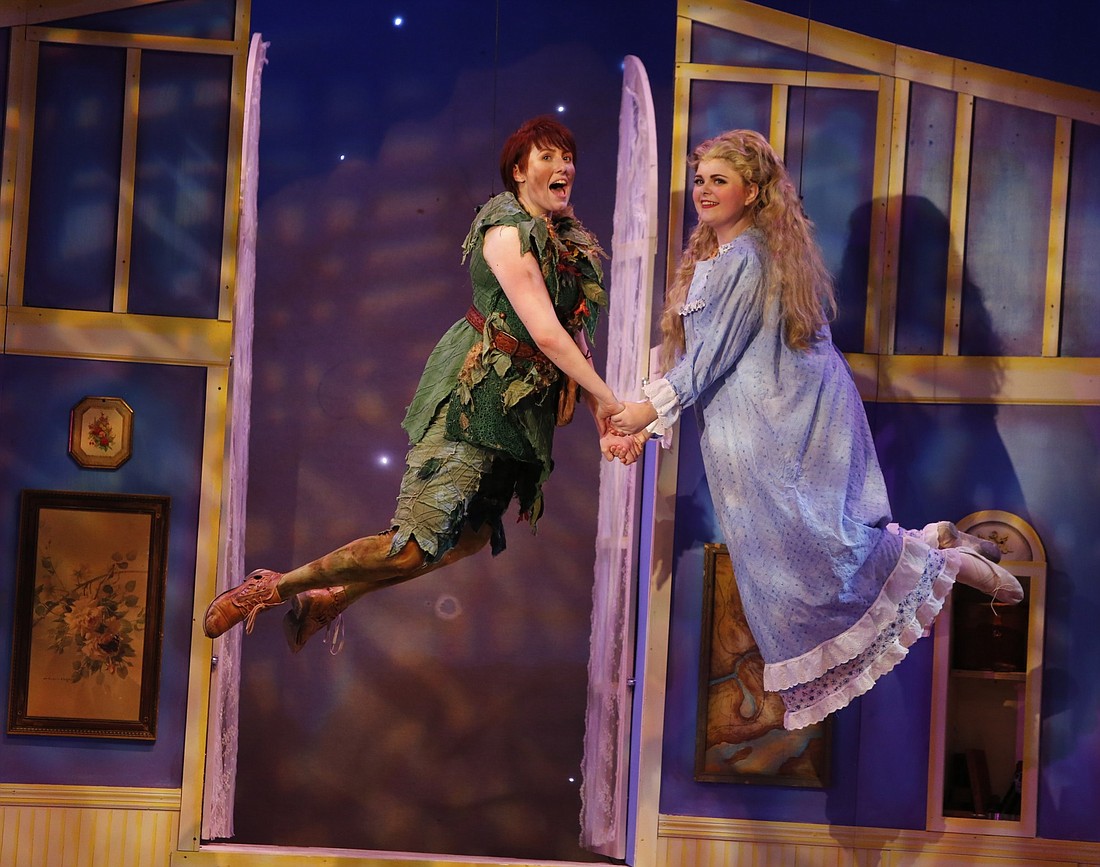- April 29, 2025
-
-
Loading

Loading

More than 100 years ago, children in London reported sightings of a flying being — a boy — apparently human, who claimed an ageless immortality. Said entity offered to take them to his home world of “Neverland,” a dimension where the aging process had stopped. The name of this alien?
Peter Pan.
This is also the title of Venice Theatres current production — Jerome Robbins’ 1954 musical adaptation of J.M. Barrie’s fictionalized account of these Edwardian abductions. Anecdotally, the Scottish author based his original story on accounts given by the few who returned: specifically the three children of the Darling family: Wendy, Michael and John. They agree on these salient points:
Neverland was inhabited by the “Lost Boys” (human male toddlers who fell out of their prams); pirates led by Captain Hook and Native Americans of an unidentified tribe. The Lost Boys craved the structure of a father, a mother and a home. Peter saw Wendy as a mother figure and “invited” her for that reason; her brothers evidently came along for the ride. That ride had its share of dangers. Neverland was a real place, and not merely in the mind. You could die there, and probably not by accident. Captain Hook and his pirates did their best to kill Peter Pan and the Lost Boys. A crocodile with a clock in his stomach did its best to eat Captain Hook. (Screenwriters refer to him as the “ticking croc.”) Other dangers were more personal: If Wendy began a romantic relationship with Peter, the aging process will resume. (Though I may be thinking of “Miri” —that original “Star Trek” starring Michael J. Pollard. But I digress,) Peter eventually returned the Darling children (and the surviving Lost Boys, as well) to London. Not wishing to age, Peter flew back to Neverland. But he periodically returned to visit Wendy’s daughter.
This may sound like disturbing material, but under Brad Wages’ direction, it’s fast-moving and fun.
The large-cast production draws on the youthful talents of Venice Theatre’s summer stock program. Savannah Sinclair is a pitch-perfect Pan: the anarchic embodiment of rule-defying eternal youth. She’s a ball of pure energy who takes to the air like she was born to fly. Bea Kelly’s Wendy, Charles Shoemaker’s Michael and Ben Hoermann’s John enjoy their flights as well. Nethaneel Williams’s Hook nicely captures the wounded, passive aggressive narcissism of the character. Pan, for no good reason, is full of joy; Hook takes it as a personal insult. He’s also great as the Darling’s father (more on that later) Morgan Graves is also fine in multiple roles of Mrs. Darling, Smee (Hook’s abused underling) and Wendy as an adult. Anna Sand-Lambert’s delivered a balletic portrayal of Tiger Lily; somewhere under a shaggy dog costume, Megan Hartnett channeled the canine protectiveness of Nana, the Darling’s sheepdog nanny. A green laser spotlight was scintillating in the role of Tinkerbell.
And let’s give credit where it’s due to the creative team. Excellent work by technical director John Andzulis, flight director Terry Nelson, and fight choreographer Peter Ivanov. (For a look at their backstage magic, check out our July 21 article.) Teresa O’Connell’s musical direction is suitably lighthearted. Jonathan Hall’s costumes and Christian Londos’ set design are inventive, but stop short of deconstructing the familiar dream. Expect a classic Pan in a classic Neverland—and a whole lot of fun.
The songs from Robbins’ Broadway production add to the fun—a different batch than the Disney movie. Familiar faves include “I Won’t Grow Up,” “Never Never Land,” and “I’ve Got to Crow.” If you grew up with Mary Martin, these tunes were burned in your brain. But after sufficient decades, they’re fun again. And they’re always fun the first time. But enough talk of fun. Let’s talk about truth ...
And the truth is out there.
Barrie could’ve laid claim to the wildest imagination of all time if he’d actually invented this gravity-defying tale. (Freudian theorists claim he did just that—and have devoted shelves of research to this theory.) But seriously… an Edwardian family who has a dog for a nanny? A flying boy who doesn’t want to grow up? You can’t make these things up. Arguably, Barrie fictionalized the narrative to a certain degree. As to the unedited truth behind his fiction, one glaring clue hides in plain sight …
Captain Hook and Mr. Darling are always played by the same actor.
Yes, a crocodile eats the pirate in the end. But legend persists that Hook’s last words were: “Peter Pan — I am your Father! Join me, and we can rule Neverland together as father and son!”
Anecdotally, this line was included in the premiere of “Peter Pan,” but cut from all subsequent performances — and never included in any printed edition of the novel or play.
For what it’s worth, reports of close encounters with the green-skinned, flying alien ceased after Barrie’s play opened in 1904.
Peter Pan’s connection to peanut butter remains unknown.